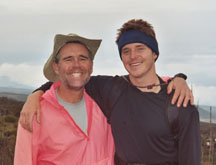|
Web Exclusives: PawPlus
October 5, 2005: Climbing
Kilimanjaro By ERIC F. EDMUNDS JR. ’75 “Pole, pole,” intoned the guide – Swahili for slowly, slowly. It was half-past midnight on June 23 as we emerged into the clear bracing air of 15,000 feet from our barely warmed hut. The Southern Cross shone brightly in the night sky and the full moon illuminated the snows of Kilimanjaro, 4,000 steep feet above us. We were five: a UCLA friend who had summited McKinley; his girlfriend, a two-time Hawaii Ironman triathlete; an ultra-distance running friend; me; and my son Alex – newly graduated from high school, soon to join Princeton’s Class of 2009 and its championship water polo team. The thin air quickly took its toll. The temperature, freezing as we started, began to drop. The loose scree crumbled underfoot, all the while our guide urging us “pole pole.” Passing the Hans Meyer cave at 16,000 feet (Meyer was the first white man to reach the summit, in 1889), we saw other climbers turning back with altitude sickness or, more alarming, pulmonary edema. On we pushed into the night. To our dismay, the first wisps of fog appeared. By 3 a.m., clouds concealed the snowcapped summit. Vegetation and all signs of green were a memory. Kilimanjaro is a remarkable mélange of five ascending “zones” or micro-climes: Beginning at about 5,000 feet, tropical jungle and cloud-forest; next, temperate woods of pine and ferns; followed by high alpine meadows, filled with clear creeks, bizarre lobelia trees and exotic wildflowers; then barren wind-swept plains; and finally, the so-called Arctic Zone, covered by snow, ice, and slippery rock. We donned down parkas, Gore-Tex shells, ski gloves, and masks. We reached Gilman’s Point, on the edge of the volcanic crater, altitude 18,655 feet, at 4:49 a.m. Here we caught our breaths and drank some last water before the canteens froze, readying for the final push to the summit, at 19,340 feet the highest point on the African continent. The winds increased to a howling 40 mph, the temperature dropped to 8 degrees Fahrenheit, and snow blew horizontally in the darkness. We reached Uhuru Peak ahead of schedule at 6:05 a.m. There would be no traditional sunrise photos of the crater for us. Two days later, we were back at the trailhead, buying obligatory rounds of beers for the successful guides and porters. In return, they rose and sang us a Swahili song about “Kili.” It occurred to us that the government-decreed requirement for guides on the mountain is a Full Employment Act for the otherwise impoverished (but fit) residents of northern Tanzania. The scenery and vistas on Kilimanjaro are beyond compare. Later, as we gazed up at the peak from the flat plains and wispy acacia trees of Kenya’s Amboseli Game Reserve, with elephant and zebras grazing before us, and later still looking down at the peak from our flight home, we were struck by the majesty of Kilimanjaro. Hemingway famously wrote that a leopard was found embalmed in the snows of its peak. A more timely point of controversy is the well-documented fact that Kilimanjaro is losing its ice cap to global warming. The first explorer, Meyer, could barely reach the peak for the forest of ice formations and fields blocking his path. Today these are gone, and the ice inside the crater shrinks annually. For us, meanwhile, it was a father-and-son moment to remember.
Alex is leaving the nest, and soon would be ensconced in the Princeton
cocoon of new discoveries and parentless living. In May he marched
in the P-rade, alongside my 30th reunion classmates. But “Kili”
is a march neither of us will soon forget. ERIC F. EDMUNDS JR. ’75
|
||

